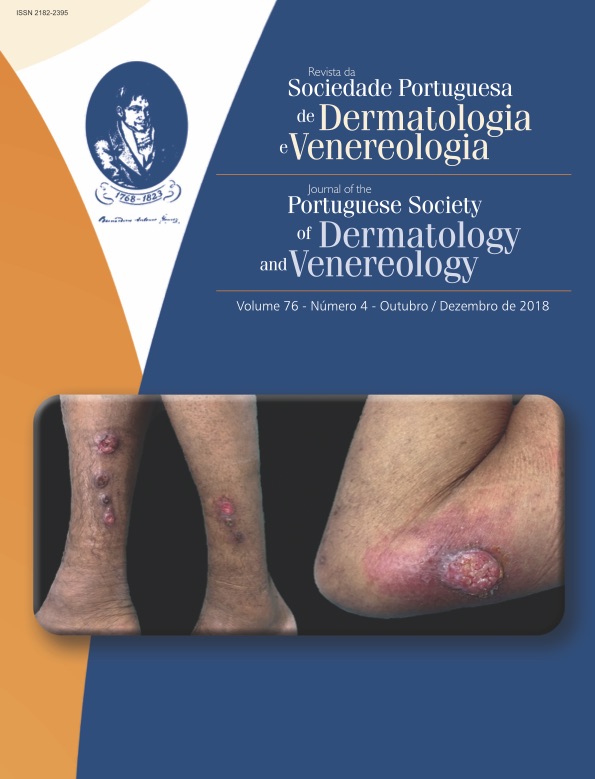As Controvérsias da Vitamina D: O Que o Dermatologista Precisa de Saber
Resumo
A vitamina D3 (colecalciferol) é um precursor de hormonas esteróides e é sintetizada quando a pele é exposta à radiação ultravioleta B. Também está presente num número limitado de alimentos, especialmente peixes gordos. As duas principais fontes de vitamina D são a exposição solar e a ingestão oral, incluindo a ingestão dietética e suplementação. Vários fatores podem influenciar o status da vitamina D no organismo. Esta vitamina tem efeitos bem conhecidos no metabolismo do cálcio e está tradicionalmente ligada à prevenção de raquitismo em crianças e fraturas ósseas em idosos. Como os recetores de vitamina D estão presentes em vários órgãos e tecidos, a vitamina D pode ter efeitos extraesqueléticos, tendo atraído muita atenção como possível fator preventivo para um grande número gama de doenças crónicas. Os autores reviram a literatura com o objetivo de fornecer ao dermatologista um documento simples e sucinto, relevante para a prática clínica diária. Nos dias de hoje, é de destacar a falta de evidência de qualidade para apoiar a avaliação e suplementação de vitamina D em doenças dermatológicas.
Downloads
Referências
LeFevre ML. Screening for Vitamin D Deficiency in Adults:
U.S. Preventive Services Task Force Recommendation
Statement. Ann Intern Med. 2015; 162: 133-40. doi:
7326/M14-2450.+
LeFevre ML, LeFevre NM. Vitamin D screening and supplementation
in community-dwelling adults: common
questions and answers. Am Fam Physician. 2018; 97:
-60.
Lin KW. Vitamin D screening and supplementation in primary
care: time to curb our enthusiasm. Am Fam Physician.
; 97:226-7.
Theodoratou E, Tzoulaki I, Zgaga L, Ioannidis JP. Vitamin
D and multiple health outcomes: umbrella review of
systematic reviews and meta-analyses of observational
studies and randomised trials. BMJ. 2014; 348:g2035.
doi: 10.1136/bmj.g2035.
Silva JM, Teixeira CS, Correia M. Vitamina D e melanoma.
Rev Soc Port Dermatol Venereol. 2017; 75: 37-41.
Pludowski P, Holick MF, Grant WB, Konstantynowicz
J, Mascarenhas MR, Haq A, et al. Vitamin D supplementation
guidelines. J Steroid Biochem Mol Biol.
;175:125-35. doi: 10.1016/j.jsbmb.2017.01.021
Vaz-Carneiro A. A Vitamina D na prevenção de doenças
crónicas: uma análise baseada na evidência científica.
Acta Med Port. 2017; 30: 351-3.
Cunha N, Campos S, Serrão V. Vitamin D levels in a cohort
of Portuguese melanoma patients relate to time of
follow-up from diagnosis, sun exposure behaviour, and
use of photoprotection. Eur J Dermatol. 2018, 28:93-4.
doi: 10.1684/ejd.2017.3161.
Buckley L, Guyatt G, Fink HA, Cannon M, Grossman
J, Hansen KE, et al. 2017 American College of Rheumatology
guideline for the prevention and treatment of
glucocorticoid-induced osteoporosis. Arthritis Rheumatol.
; 69: 1521-37. doi: 10.1002/art.40137.
Fang S, Sui D, Wang Y, Liu H, Chiang YJ, Ross MI, et
al. Association of vitamin D levels with melanoma patient
outcome after adjustment for C-reactive protein.
J Clin Oncol. 2016;34:1741-7. doi: 10.1200/
JCO.2015.64.1357.
Newton-Bishop JA, Davies JR, Latheef F, Randerson-Moor
J, Chan M, Gascoyne J, et al. 25-Hydroxyvitamin D2/
D3 levels and factors associated with systemic inflammation
and melanoma survival in the Leeds melanoma
cohort. Int J Cancer. 2015; 136:2890-9. doi: 10.1002/
ijc.29334.
Sondak VK, McIver B, Kanetsky PA. Vitamin D and melanoma:
what do we tell our patients? J Clin Oncol.
;34:1713-4. doi: 10.1200/JCO.2016.66.5240.
Rizzoli R, Boonen S, Brandi ML, Bruyère O, Cooper C,
Kanis JA, et al. Vitamin D supplementation in elderly or
postmenopausal women: a 2013 update of the 2008 recommendations
from the European Society for Clinical
and Economic Aspects of Osteoporosis and Osteoarthritis
(ESCEO). Curr Med Res Opin. 2013;29:305-13. doi:
1185/03007995.2013.766162.
Grigalavicius M, Moan J, Dahlback A, Juzeniene A. Daily,
seasonal, and latitudinal variations in solar ultraviolet A
and B radiation in relation to vitamin D production and
risk for skin cancer. Int J Dermatol. 2016;55: e23-8. doi:
1111/ijd.13065.
Direção Geral da Saúde. Circular Informativa nº13/
DSCS/DPCD/DSQC de 01/04/2008- DGS. Lisboa:
DGS; 2008.
LeBlanc ES,Zakher B, Daeges M, Pappas M, Chou R.
Screening for vitamin D deficiency: a systematic review
for the U.S. Preventive Services Task Force. Ann Intern
Med. 2015; 162:109-122. doi: 10.7326/M14-1659.
Todos os artigos desta revista são de acesso aberto sob a licença internacional Creative Commons Attribution-NonCommercial 4.0 (CC BY-NC 4.0).








